Load test of a Polonceau truss
Table of contents
Project data
| Titel | Title Belastungstest an einem Polonceau-Binder im Park Sanssouci | Load test of a Polonceau truss in Sanssouci Park Auftraggeber | Client Stiftung Preußische Schlösser und Gärten, Berlin-Brandenburg, Potsdam Zeitraum | Period 09 – 11/2022 Leiter | Project manager Dr.-Ing. Torsten Hampel Team | Team Dr.-Ing. Torsten Hampel, Dipl.-Ing. (FH) Sabine Wellner, Bernd Wehner, Heiko Wachtel Projektpartner | Project partner Brandenburger Montage und Kranservice GmbH (BMK), Potsdam |
Short report

Historic Polonceau truss in the remise of Sanssouci Park
The depot at the historic mill in Sanssouci Park in Potsdam is to be expanded as part of the new visitor’s center. The depot was originally built in 1861/62 by Ludwig Ferdinand Hesse on behalf of King Friedrich Wilhelm IV as a multi-part hall for storing wagons and carriages. The special feature of this depot are five Polonceau or Wiegmann trusses which span the hall in the transverse direction over the clear width of around 9.5 m.
The structural analysis by the project engineer has shown that the building is generally well suited for the planned use from a structural point of view. However, it was seen as problematic that the historic roof structure has to bear loads due to a heavy slate double roofing in accordance with the monument preservation concept, a PV system as well as an additional insulation level including panelling. These additional loads significantly exceed the total weight of the existing single slate roofing or sheet metal roofing. Therefore, the roof structure consisting of purlins and Polonceau trusses could not be verified mathematically or via load comparisons, so that the load-bearing capacity should be determined experimentally by means of a in situ load test.

Test set-up
The load test was carried out on a truss that had been already been renovated as a sample in terms of wood technology. Thus, load-bearing reserves could be taken into account compared to the unrestored condition. Conclusions were expected about the loads that could be carried and indications for possible strengthening of the binder system that would be compatible with the preservation of monuments.
All intended loads were successfully introduced into the structure, which absorbed these loads without any negative reactions. There was only a minimal difference in the test target load. Instead of the desired 62 kN only around 61 kN could be achieved. At this loading, one of the side abutments realised by crane ballast was lifted. As a result, no further load increase could be achieved from this point on. However, it can be assumed that the truss would have withstood the existing difference of 1 kN without any problems, as it did not show any critical reactions up to this load. On the contrary, it endured repeated attempts to reach the target load without any appreciable increases in deformation. Furthermore, it was demonstrated that the wood technological renovation is effective in its current state, and can therefore be carried out in this way.
